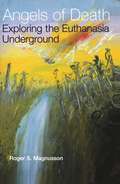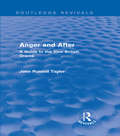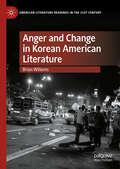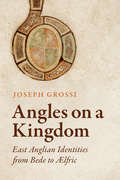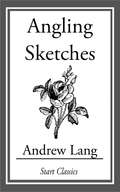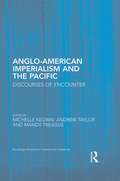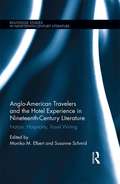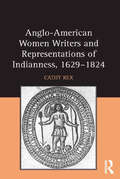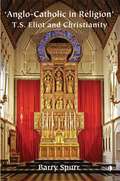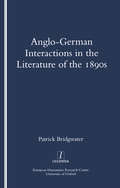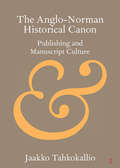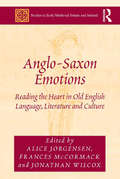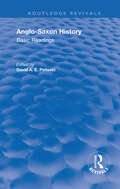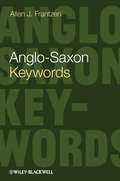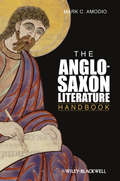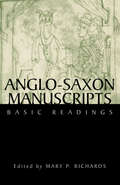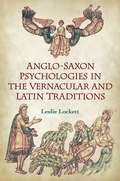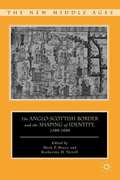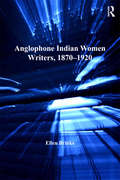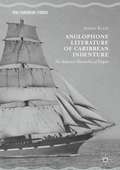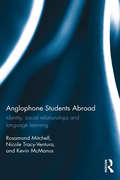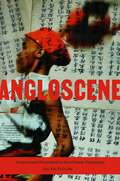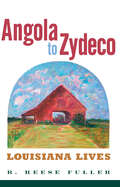- Table View
- List View
Angels of Death: Exploring the Euthanasia Underground
by Roger S. MagnussonPublic discussion of euthanasia and assisted suicide is growing. In Australia as elsewhere the debate is difficult, contentious and confronting, and hampered by the secrecy that necessarily surrounds illegal practice. Most people simply have no way of knowing how, and how often, medically assisted death actually occurs.Roger Magnusson presents, for the first time, detailed first-hand accounts by doctors, nurses, therapists and other health professionals who have been participants in assisted death. All have been intimately involved in caring for people with AIDS, both in Australia and in California. He places these ambivalent, self-incriminating accounts within the broader context of the right-to-die debate and the challenges of palliative care.The frankness of the health workers and the richness of their collected evidence set this book apart. From within a culture of deception they speak knowingly and movingly of the merciful release of a peaceful death, while acknowledging the reality of 'botched attempts', euthanasia without consent, precipitative euthanasia, lack of accountability and professional distance, and many other disturbing issues.Angels of Death provides a window into the 'euthanasia underground'—a secret part of medicine and nursing that few professionals will publicly acknowledge. It brings a sense of urgency and precision to public debate, and equips us all to think more independently about these crucial issues.
Angels of Modernism
by Suzanne HobsonAngels of Modernism explores the many and various ways that angels are represented in modernist literary cultures. Seen by the likes of D. H. Lawrence, H. D. and Virginia Woolf as belonging to a religious or Victorian past, the angel might easily have been consigned to history along with other tropes considered too old-fashioned or sentimental for modern(ist) literary tastes. This book argues that it is precisely the angel's lack of fit with self-consciously modern attitudes to art and belief that explains its continued attraction to modernist writers as well as its capacity to generate new meanings. On the one hand, the angel appears as a symbol of resistance to secularizing tendencies in aesthetics and religion. On the other, it is a motile figure appropriated and transformed by a variety of interests from sex-reform campaigners to designers of new utopias. From Walter Benjamin, through Djuna Barnes, H. D. , D. H. Lawrence, Wyndham Lewis, Wallace Stevens and Virginia Woolf, angels continue to perform cultural and critical work even as they are identified as incongruous and untimely.
Anger and After: A Guide to the New British Drama (Routledge Revivals)
by John Russell TaylorWhen it was first published in 1962, Anger and After was the first comprehensive study of the dramatic movement which began in 1956 with the staging of John Osborne’s Look Back in Anger and has since brought forward such dramatists as Brendan Behan, Harold Pinter, N. F. Simpson, John Arden and Arnold Wesker. Thoroughly revised in 1969, this book remains important reading for theatre students in need of a comprehensive and authoritative guide to post-Osborne drama in Britain.
Anger and Change in Korean American Literature (American Literature Readings in the 21st Century)
by Brian WillemsThis book illustrates how Korean American novels and poetry use anger to enact change, foregrounding the various ways it can pinpoint injustice and suggest alternatives. Experiences of the "forgotten" Korean War, Korean military-mediated immigration to the US in the twentieth century, and the role of Korean Americans in some of the largest upheavals in American history all inform a specific relation to anger and both its expression and use in Korean American literature. Through various texts comprised of both poetry and prose from authors including Steph Cha, Cathy Park Hong, Eugene Lim, and Yongsoo Park, Willems highlights how anger is seen to function in some contexts as a positive fulcrum for change.
Angles on a Kingdom: East Anglian Identities from Bede to Ælfric
by Joseph GrossiFrom the eighth century to the turn of the millennium, East Anglia had a variety of identities thrust upon it by authors of the period who envisioned a unified England. Although they were not regional writers in the modern sense, Bede, Felix, the annalists of the Anglo-Saxon Chronicle, King Alfred of Wessex, Abbo of Fleury, and Ælfric of Eynsham took a keen interest in East Anglia, especially in its potential to undo English cultural cohesiveness as they imagined it. Angles on a Kingdom argues that those authors treated East Anglia as both a hindrance and a stimulus to the development of early English "national" consciousness. Combining close textual reading with consideration of early medieval barrow burials, coinage, border delineation, and rivalries between monastic houses, Joseph Grossi examines various forms of cultural affirmation and manipulation. Angles on a Kingdom shows that, over the course of roughly two and a half centuries, the literary metamorphoses of East Anglia hint at the region’s recurring tensions with its neighbours – tensions which suggest that writers who sought to depict a coherent England downplayed what they deemed to be dangerous impulses emanating from the island’s easternmost corner.
Angling Sketches
by Andrew LangAndrew Lang (1844-1912) was a prolific Scots man of letters, a poet, novelist, literary critic and contributor to anthropology. He now is best known as the collector of folk and fairy tales. As a journalist, poet, critic and historian, he soon made a reputation as one of the ablest and most versatile writers of the day. Lang was one of the founders of the study of "Psychical Research," and his other writings on anthropology include The Book of Dreams and Ghosts (1897), Magic and Religion (1901) and The Secret of the Totem (1905). He was a Homeric scholar of conservative views. Other works include Homer and the Epic (1893); a prose translation of The Homeric Hymns (1899), with literary and mythological essays in which he draws parallels between Greek myths and other mythologies; and Homer and his Age (1906). He also wrote Ballades in Blue China (1880) and Rhymes la Mode (1884).
Anglo-American Imperialism and the Pacific: Discourses of Encounter (Routledge Research in Postcolonial Literatures)
by Michelle Keown Andrew Taylor Mandy TreagusThis interdisciplinary collection explores the confluence of American and British (neo)imperalism in the Pacific, as represented in various forms of Pacific discourse including literature, ethnography, film, painting, autobiography, journalism, and environmental discourse. It investigates the alliances and rivalries between these two colonial powers during the crucial transition period of the early-to-mid twentieth century, also exploring indigenous Pacific responses to Anglo-American imperialism during and beyond the decolonization period of the late twentieth century. While the relationship between Britain and the US has been analyzed through prominent forms of economic and cultural exchange between Europe, Africa, and the Americas, there is to date no sustained study of the relationship between British and US colonial expansion into the Pacific, which became central to ideas of developing ‘European’ modernity in the late eighteenth century and has played a pivotal in the history of Anglo-American colonialism, from the establishment of plantation economies and settler colonies in the nineteenth century to various forms of military imperialism during and beyond the twentieth century. The wide range of discursive and expressive modes explored in this collection makes for a rich and multifaceted analysis of representations of, and responses to, Anglo-American imperialism, and is in keeping with the current interdisciplinary turn in postcolonial studies.
Anglo-American Travelers and the Hotel Experience in Nineteenth-Century Literature: Nation, Hospitality, Travel Writing (Routledge Studies in Nineteenth Century Literature)
by Monika M Elbert Susanne SchmidThis volume examines the hotel experience of Anglo-American travelers in the nineteenth century from the viewpoint of literary and cultural studies as well as spatiality theory. Focusing on the social and imaginary space of the hotel in fiction, periodicals, diaries, and travel accounts, the essays shed new light on nineteenth-century notions of travel writing. Analyzing the liminal space of the hotel affords a new way of understanding the freedoms and restrictions felt by travelers from different social classes and nations. As an environment that forced travelers to reimagine themselves or their cultural backgrounds, the hotel could provide exhilarating moments of self-discovery or dangerous feelings of alienation. It could prove liberating to the tourist seeking an escape from prescribed gender roles or social class constructs. The book addresses changing notions of nationality, social class, and gender in a variety of expansive or oppressive hotel milieu: in the private space of the hotel room and in the public spaces (foyers, parlors, dining areas). Sections address topics including nationalism and imperialism; the mundane vs. the supernatural; comfort and capitalist excess; assignations, trysts, and memorable encounters in hotels; and women’s travels. The book also offers a brief history of inns and hotels of the time period, emphasizing how hotels play a large role in literary texts, where they frequently reflect order and disorder in a personal and/or national context. This collection will appeal to scholars in literature, travel writing, history, cultural studies, and transnational studies, and to those with interest in travel and tourism, hospitality, and domesticity.
Anglo-American Women Writers and Representations of Indianness, 1629-1824
by Cathy RexExamining the appropriations and revisions of Indian identity first carried out by Anglo-American engravers and later by early Anglo-American women writers, Cathy Rex shows the ways in which iconic images of Native figures inform not only an emerging colonial/early republican American identity but also the authorial identity of white women writers. Women such as Mary Rowlandson, Ann Eliza Bleecker, Lydia Maria Child, and the pseudonymous Unca Eliza Winkfield of The Female American, Rex argues, co-opted and revised images of Indianness such as those found in the Massachusetts Bay Colony seal and the numerous variations of Pocahontas’s image based on Simon Van de Passe’s original 1616 engraving. Doing so allowed them to posit their own identities and presumed superiority as American women writers. Sometimes ugly, occasionally problematic, and often patently racist, the Indian writings of these women nevertheless question the masculinist and Eurocentric discourses governing an American identity that has always had Indianness at its core. Rather than treating early American images and icons as ancillary to literary works, Rex places them in conversation with one another, suggesting that these well-known narratives and images are mutually constitutive. The result is a new, more textually inclusive perspective on the field of early American studies.
Anglo-Catholic in Religion: T. S. Eliot and Christianity
by Barry SpurrBarry Spurr's eagerly-awaited, definitive study of T. S. Eliot's Anglo-Catholic belief and practice shows how the poet's religion shaped his life and work for almost forty years, until his death in 1965. The author examines Eliot's formal adoption of Anglo-Catholicism, in 1927, as the culmination of his intellectual, cultural, artistic, spiritual and personal development to that point. This book presents the first detailed analysis of the unique influence that Anglo-Catholicism's doctrinal and devotional principles, and its social teaching, had on Eliot's poetry, plays, prose and personal life. An informed presentation and discussion of Anglo-Catholicism at the time of Eliot's conversion and through the subsequent decades of his Christian faith and practice. Significant new material from correspondence and diaries which sheds light on Eliot's thought, poetry and prose. This book is essential reading for all scholars and readers of T. S. Eliot and his circle; for students and devotees of Anglo-Catholicism, and scholars of the interaction between literature and theology, especially in the twentieth century. It will also be of use to senior and Honours-level undergraduates and postgraduate research students working in the fields of Modernism and its principles and belief systems, and for students of religion, especially Western Christianity and Anglicanism.
Anglo-German Interactions in the Literature of the 1890s
by Patrick Bridgwater"This is a study of what the main ""aesthetic"" writers of late 19th-century Britain made of German literature, and of how Germany in turn reacted to them. The impact of Anglo-Scottish art nouveau in fin-de-siecle Austria and Germany made it predictable that Keats, Pater and Rossetti, among others, would be well received, but no one could have known in advance that by the time of their deaths, Swinburne and Wilde would be more highly regarded in Germany than in Britain. Bridgwater's documented study casts light on the central cultural issues of the day, including ideas of morality, truth and subjectivism in art, comparing Pater and Wilde with Nietzsche, and George Moore, that chameleon of the decadent 90s, with Schopenhauer."
The Anglo-Norman Historical Canon: Publishing and Manuscript Culture (Elements in Publishing and Book Culture)
by Jaakko TahkokallioThis Element is a contribution to the ongoing debate on what it meant to publish a book in manuscript. It offers case-studies of three twelfth-century Anglo-Norman historians: William of Malmesbury, Henry of Huntingdon, and Geoffrey of Monmouth. It argues that the contemporary success and rapid attainment of canonical authority for their histories was in significant measure the result of successfully conducted publishing activities. These activities are analysed using the concept of a 'publishing circle'. This concept, it is suggested, may have wider utility in the study of authorial publishing in a manuscript culture. This Element is also available as Open Access.
Anglo-Saxon Emotions: Reading the Heart in Old English Language, Literature and Culture (Studies in Early Medieval Britain and Ireland)
by Alice Jorgensen Frances McCormack Jonathan WilcoxResearch into the emotions is beginning to gain momentum in Anglo-Saxon studies. In order to integrate early medieval Britain into the wider scholarly research into the history of emotions (a major theme in other fields and a key field in interdisciplinary studies), this volume brings together established scholars, who have already made significant contributions to the study of Anglo-Saxon mental and emotional life, with younger scholars. The volume presents a tight focus - on emotion (rather than psychological life more generally), on Anglo-Saxon England and on language and literature - with contrasting approaches that will open up debate. The volume considers a range of methodologies and theoretical perspectives, examines the interplay of emotion and textuality, explores how emotion is conveyed through gesture, interrogates emotions in religious devotional literature, and considers the place of emotion in heroic culture. Each chapter asks questions about what is culturally distinctive about emotion in Anglo-Saxon England and what interpretative moves have to be made to read emotion in Old English texts, as well as considering how ideas about and representations of emotion might relate to lived experience. Taken together the essays in this collection indicate the current state of the field and preview important work to come. By exploring methodologies and materials for the study of Anglo-Saxon emotions, particularly focusing on Old English language and literature, it will both stimulate further study within the discipline and make a distinctive contribution to the wider interdisciplinary conversation about emotions.
Anglo-Saxon History: Basic Readings
by David A. E. PelteretFirst published in 2000, Basic Readings in Anglo-Saxon England (BRASE) is a series of volumes that collect classic, exemplary, or ground-breaking essays in the fields of Anglo-Saxon studies generally written in the 1960s or later, or commissioned by a volume editor to fulfill the purpose of the given volume. This, the sixth volume in the series, is the first devoted to history and the first edited by a scholar outside the field of literary study. David Pelteret has collected fifteen previously published essays: the first nine of his essays present a conspectus of Anglo-Saxon history; the other seven are spread among seven "Special Approaches": Anthropology, Archaeology, Art History, Economic and Comparative History, Geography and Geology, Place-Names, and Topography and Archaeology.
Anglo-Saxon Keywords (Keywords in Literature and Culture (KILC). #2)
by Allen J. FrantzenAnglo-Saxon Keywords presents a series of entries that reveal the links between modern ideas and scholarship and the central concepts of Anglo-Saxon literature, language, and material culture. Reveals important links between central concepts of the Anglo-Saxon period and issues we think about today Reveals how material culture—the history of labor, medicine, technology, identity, masculinity, sex, food, land use—is as important as the history of ideas Offers a richly theorized approach that intersects with many disciplines inside and outside of medieval studies
The Anglo Saxon Literature Handbook
by Mark C. AmodioThe Anglo-Saxon Literature Handbook presents an accessible introduction to the surviving works of prose and poetry produced in Anglo-Saxon England, from AD 410-1066.Makes Anglo-Saxon literature accessible to modern readersHelps readers to overcome the linguistic, aesthetic and cultural barriers to understanding and appreciating Anglo-Saxon verse and proseIntroduces readers to the language, politics, and religion of the Anglo-Saxon literary worldPresents original readings of such works as Beowulf, The Battle of Maldon, The Wanderer, The Seafarer, and The Anglo-Saxon Chronicle
Anglo-Saxon Manuscripts: Basic Readings (Basic Readings in Chaucer and His Time)
by Mary P. RichardsThe study of manuscripts is fundamental to the appreciation of Anglo-Saxon texts and culture. Anglo-Saxon Manuscripts: Basic Readings provides an introductory collection of materials covering basic terms, techniques, resources, issues, and applications. Focusing on manuscripts copied before 1100 in England, the selections gathered here consider their history, production, analysis, and significance. Drawn from a variety of published sources and new writings commissioned for this collection, these essays offer a thorough background in principles and practices, along with up-to-date coverage of new developments in paleography. This interdisciplinary collection introduces key subjects of research for Anglo-Saxon studies while suggesting potential developments and new directions within the field.
Anglo-Saxon Psychologies in the Vernacular and Latin Traditions
by Leslie LockettOld English verse and prose depict the human mind as a corporeal entity located in the chest cavity, susceptible to spatial and thermal changes corresponding to the psychological states: it was thought that emotions such as rage, grief, and yearning could cause the contents of the chest to grow warm, boil, or be constricted by pressure. While readers usually assume the metaphorical nature of such literary images, Leslie Lockett, in Anglo-Saxon Psychologies in the Vernacular and Latin Traditions, argues that these depictions are literal representations of Anglo-Saxon folk psychology.Lockett analyses both well-studied and little-known texts, including Insular Latin grammars, The Ruin, the Old English Soliloquies, The Rhyming Poem, and the writings of Patrick, Bishop of Dublin. She demonstrates that the Platonist-Christian theory of the incorporeal mind was known to very few Anglo-Saxons throughout most of the period, while the concept of mind-in-the-heart remained widespread. Anglo-Saxon Psychologies in the Vernacular and Latin Traditions examines the interactions of rival - and incompatible - concepts of the mind in a highly original way.
The Anglo-Scottish Border and the Shaping of Identity, 1300–1600
by Mark P. Bruce Katherine H. Terrell"Theorizing the Borders: Scotland and the Shaping of Identity in Medieval Britain" explores the roles that Scotland and England play in one another's imaginations. This collection of essays brings together eminent scholars and emerging voices from the frequently divergent fields of English and Scottish medieval studies to address such questions as: How do subjects on both sides of the Anglo-Scottish border define themselves in relation to one another? In what ways do they influence each other's sense of historical, cultural, and national identity? What stories do they tell about one another, and to what ends? How does the shifting political balance - as well as the shifting border - between the two kingdoms complicate notions of Scottishness and Englishness? What happens to important texts, genres, and even poetic forms when they cross this border? How do texts produced in the Anglo-Scottish borderlands transform mainstream notions of Scottish and English identities?
Anglophone Indian Women Writers, 1870–1920
by Ellen BrinksThe result of extensive archival recovery work, Ellen Brinks's study fills a significant gap in our understanding of women's literary history of the South Asian subcontinent under colonialism and of Indian women's contributions and responses to developing cultural and political nationalism. As Brinks shows, the invisibility of Anglophone Indian women writers cannot be explained simply as a matter of colonial marginalization or as a function of dominant theoretical approaches that reduce Indian women to the status of figures or tropes. The received narrative that British imperialism in India was perpetuated with little cultural contact between the colonizers and the colonized population is complicated by writers such as Toru Dutt, Krupabai Satthianadhan, Pandita Ramabai, Cornelia Sorabji, and Sarojini Naidu. All five women found large audiences for their literary works in India and in Great Britain, and all five were also deeply rooted in and connected to both South Asian and Western cultures. Their works created new zones of cultural contact and exchange that challenge postcolonial theory's tendencies towards abstract notions of the colonized women as passive and of English as a de-facto instrument of cultural domination. Brinks's close readings of these texts suggest new ways of reading a range of issues central to postcolonial studies: the relationship of colonized women to the metropolitan (literary) culture; Indian and English women's separate and joint engagements in reformist and nationalist struggles; the 'translatability' of culture; the articulation strategies and complex negotiations of self-identification of Anglophone Indian women writers; and the significance and place of cultural difference.
Anglophone Literature of Caribbean Indenture: The Seductive Hierarchies of Empire (New Caribbean Studies)
by Alison KleinThis book is the first comprehensive study of Anglophone literature depicting the British Imperial system of indentured labor in the Caribbean. Through an examination of intimate relationships within indenture narratives, this text traces the seductive hierarchies of empire – the oppressive ideologies of gender, ethnicity, and class that developed under imperialism and indenture and that continue to impact the Caribbean today. It demonstrates that British colonizers, Indian and Chinese laborers, and formerly enslaved Africans negotiated struggles for political and economic power through the performance of masculinity and the control of migrant women, and that even those authors who critique empire often reinforce patriarchy as they do so. Further, it identifies a common thread within the work of those authors who resist the hierarchies of empire: a poetics of kinship, or, a focus on the importance of building familial ties across generations and across classifications of people.
Anglophone Students Abroad: Identity, Social Relationships, and Language Learning
by Rosamond Mitchell Kevin McManus Nicole Tracy-VenturaAnglophone students abroad: Identity, social relationships and language learning presents the findings of a major study of British students of French and Spanish undertaking residence abroad. The new dataset presented here provides both quantitative and qualitative information on language learning, social networking and integration and identity development during residence abroad. The book tracks in detail the language development of participants and relates this systematically to individual participants’ social and linguistic experiences and evolving relationship. It shows that language learning is increasingly dependent on students’ own agency and skill and the negotiation of identity in multilingual and lingua franca environments.
Angloscene: Compromised Personhood in Afro-Chinese Translations
by Jay Ke-SchutteA free ebook version of this title is available through Luminos, University of California Press’s Open Access publishing program. Visit www.luminosoa.org to learn more.Angloscene examines Afro-Chinese interactions within Beijing's aspirationally cosmopolitan student class. Jay Ke-Schutte explores the ways in which many contemporary interactions between Chinese and African university students are mediated through complex intersectional relationships with whiteness, the English language, and cosmopolitan aspiration. At the heart of these tensions, a question persistently emerges: How does English become more than a language—and whiteness more than a race? Engaging in this inquiry, Ke-Schutte explores twenty-first century Afro-Chinese encounters as translational events that diagram the discursive contours of a changing transnational political order—one that will certainly be shaped by African and Chinese relations.
Angola to Zydeco: Louisiana Lives
by R. Reese FullerAngola to Zydeco: Louisiana Lives is a collection of creative nonfiction pieces about the lively personalities who call south Louisiana home. Originally published in newspapers based in Lafayette—Times of Acadiana and Independent Weekly—the twenty-five profiles and features provide intriguing glimpses into the lives of well-known Louisianans such as James Lee Burke, Ernest J. Gaines, Elemore Morgan Jr., Buckwheat Zydeco, Marc Savoy, Boozoo Chavis, Calvin Borel, Santy Runyon, and Eddie Shuler. Author R. Reese Fuller also details the sometimes zany and sometimes tragic subjects that populate the cultural landscape of south Louisiana, from Tabasco peppers to Angola prison to cockfighting. Fuller brings years of experience in the newspaper industry to bear on this collection, offering behind-the-scenes access not available elsewhere. Of particular note are his interviews with musicians and local celebrities, who reveal how their love of the region has influenced their work. Fuller’s natural approach to storytelling creates a book that is a joy to read and truly represents the people of south Louisiana.
